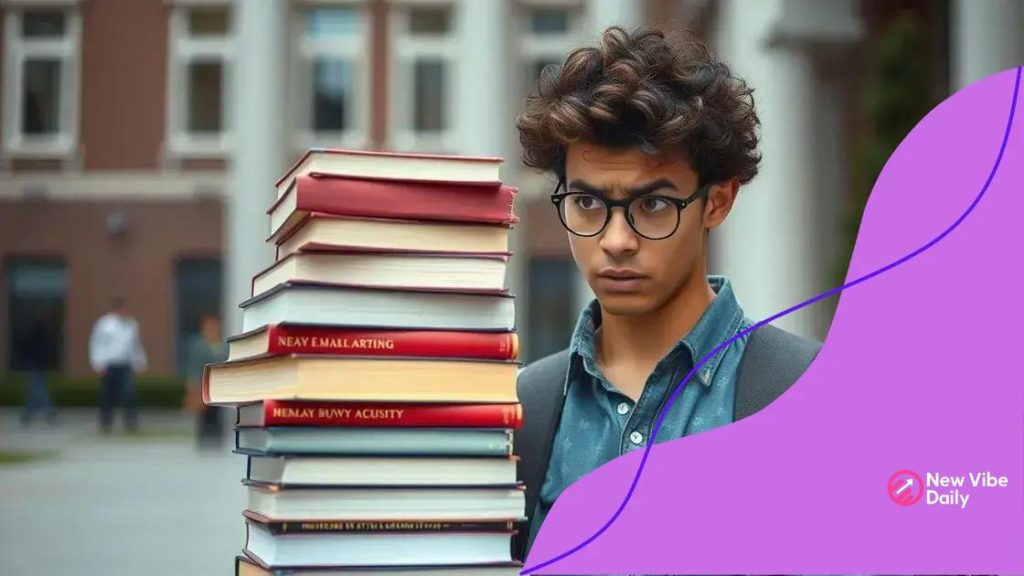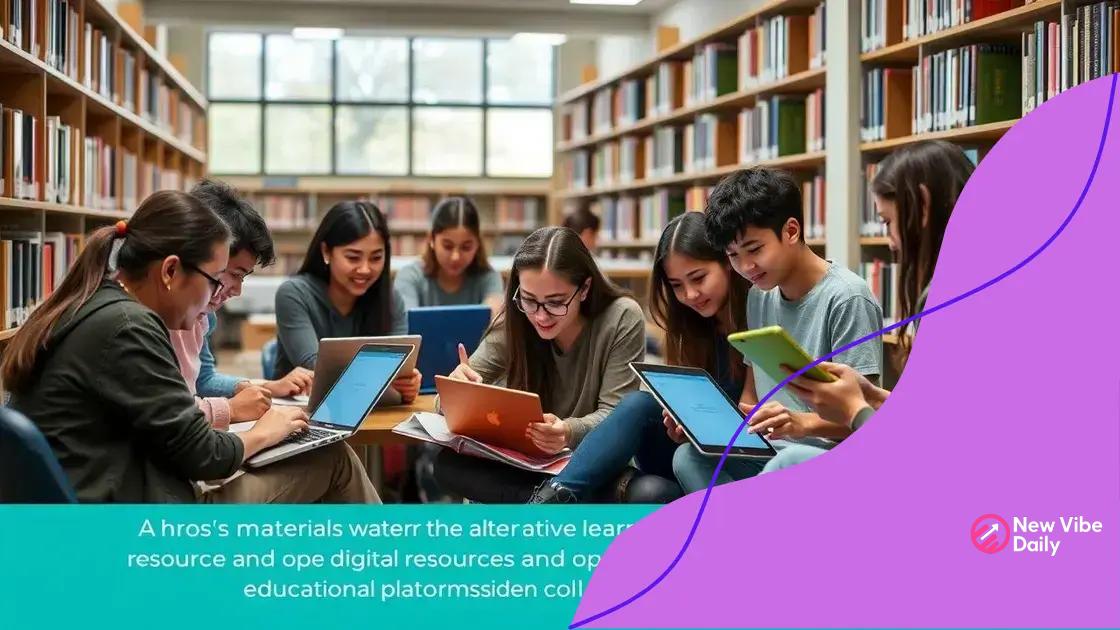Addressing the rising cost of textbooks and learning materials

Addressing the rising cost of textbooks and learning materials requires utilizing strategies like buying used books, exploring digital resources, and seeking financial aid options to significantly reduce educational expenses.
Addressing the rising cost of textbooks and learning materials is essential for students today. Who hasn’t felt the pinch from purchasing required texts? Let’s dive into solutions that make education more affordable.
Understanding the impact of rising costs
As students head back to school, the pressure of rising educational expenses becomes increasingly clear. Understanding the impact of rising costs on textbooks and learning materials is essential for students and families. Not only do high prices affect access to necessary resources, but they also influence academic performance.
Why Costs Are Rising
There are several reasons for the surge in costs. For instance, new editions of textbooks frequently hit the shelves, often with minimal changes. Publishers know students need the latest materials, so they charge a premium. Additionally, many schools only recommend specific materials, leaving students with limited choices.
- Frequent new editions
- Limited school recommendations
- Increased demand for digital access
This situation can create barriers for students, making it tough to keep up with their studies. When students struggle to purchase the required materials, their grades may suffer, and they might feel discouraged.
Impact on Learning
When students can’t afford the necessary textbooks, their overall learning experience diminishes. This gap can lead to lower confidence in academic performance and hinder a student’s success. If students are not prepared with the right resources, significant learning opportunities are lost.
Addressing the Issue
Many institutions are recognizing the rising costs and are working on solutions. Some schools are adopting open educational resources (OER) that provide free or low-cost alternatives to traditional textbooks. These resources give students access to high-quality materials without the financial burden.
Furthermore, financial aid options are being expanded to help cover these essential expenses. It’s crucial for students to stay informed about available resources and support systems within their schools.
In the face of rising costs, understanding the full effect on education empowers students to advocate for themselves and seek the help they need. With effective solutions, students might find that they can still afford the materials required for their studies without sacrificing their education.
Strategies for reducing textbook expenses
Reducing textbook expenses is crucial for students who face rising costs. There are several strategies students can use to save money while still getting the materials they need. Implementing these strategies can make a significant impact on overall education costs.
Buy Used Textbooks
One effective way to cut costs is by purchasing used textbooks. Many students sell their books at the end of the semester, and this can be a great opportunity for others to save.
- Check online marketplaces and local bookstores.
- Join student groups to find offers.
- Look for rental options at libraries.
Buying used books not only helps reduce costs, but it also promotes sustainability by reusing resources. Students should always ensure that the editions they buy are compatible with their courses.
Digital Options
Another way to save is by exploring digital textbooks. They often come at a lower price than printed versions. Many platforms offer e-books that are interactive and can be accessed on various devices.
Additionally, digital resources often allow for easy highlighting and note-taking, which can enhance the learning experience. Many students appreciate the convenience of having their materials available on their laptops or tablets.
Seek Out Open Educational Resources (OER)
Open Educational Resources are free, openly licensed materials. They include textbooks, videos, and other teaching resources that provide students with alternatives to expensive textbooks. Colleges and universities are increasingly adopting OER, making them more available.
- Visit university websites for OER initiatives.
- Check websites like OpenStax for high-quality materials.
- Access local libraries for OER options.
By utilizing OER, students can gain access to valuable content without the burden of high costs. Trying these strategies can help students significantly cut their expenses and focus on what matters most—learning.
Exploring alternative learning materials

As textbook costs continue to climb, exploring alternative learning materials is becoming crucial for students. These alternatives can provide quality education while easing financial burdens. Many options exist that can cater to different learning styles.
Open Educational Resources (OER)
Open Educational Resources (OER) have gained popularity as a cost-effective solution. These resources are free and openly licensed, which means students can access them without any cost. OER includes a range of materials such as textbooks, videos, and even entire courses.
- Visit platforms like OpenStax or OER Commons for diverse subjects.
- Utilize university libraries that might offer OER texts.
- Join student forums focused on sharing OER materials.
Using OER can help students gain high-quality resources while being financially responsible. It encourages collaborative learning and makes education more accessible.
Online Courses and Tutorials
Online platforms have changed the landscape of education. Many offer free or low-cost courses that complement traditional learning. Websites like Coursera and Khan Academy provide valuable resources across various subjects.
Students can engage in interactive lessons, which enhances understanding. Many of these platforms offer quizzes and discussions, pushing students to apply what they learn in real-life scenarios. This can be particularly beneficial for visual or hands-on learners.
Community Resources
Local libraries and community centers often have educational resources available. They may provide free workshops or access to learning materials. Many public libraries now offer digital borrowing options, which allow students to access e-books and audiobooks.
- Check library websites for online catalogs.
- Ask librarians about community learning programs.
- Participate in study groups that utilize shared resources.
By leveraging these community resources, students can gain access to various learning materials without incurring additional costs. This approach fosters collaboration and learning within the community.
These alternative materials not only provide significant savings, but they also enhance student engagement. Adopting a variety of learning resources can transform the educational experience and support diverse learning preferences.
How digital resources can help
Digital resources have become a vital part of education, providing students with convenient and accessible options. They can help ease the financial burden associated with traditional textbooks and enhance the overall learning experience.
Accessible Learning Anytime, Anywhere
One major advantage of digital resources is their accessibility. Students can access materials from anywhere at any time. This flexibility allows for studying during unexpected breaks or while commuting.
- Access to e-books and online articles
- Educational videos and lectures available on platforms like YouTube
- Interactive quizzes and tools for practice
By using digital resources, students can create their own study schedules without being tied to physical materials. This promotes independent learning and empowers them to take control of their education.
Cost-Effectiveness
Another benefit is the significant cost savings. Many digital resources are free or significantly cheaper than traditional textbooks. Students can often find free digital versions of required texts online or utilize educational platforms that offer low-cost subscriptions.
Additionally, by leveraging library systems that provide digital access, students can avoid purchasing books outright. This can be especially helpful for those on tight budgets, allowing them to access quality content without financial strain.
Engaging Learning Experience
Digital resources often offer interactive and engaging content. Unlike traditional textbooks, many online materials include videos, infographics, and interactive simulations that cater to different learning styles. This interaction not only helps to improve understanding but also makes learning more enjoyable.
- Video lectures that break down complex topics
- Simulations that illustrate real-world applications
- Gamified learning platforms encouraging active participation
These dynamic features can inspire students to explore subjects in greater depth, fostering a more profound connection to the material.
Overall, digital resources offer incredible benefits, from cost savings to enhanced engagement. As education continues to evolve, integrating these tools is essential for providing a rich learning environment that meets the needs of all students.
Navigating financial aid options
Navigating financial aid options is essential for students facing the high costs of education. Understanding the various resources available can make a significant difference in managing expenses. Many students are not fully aware of what financial aid encompasses and how to access it.
Types of Financial Aid
Financial aid comes in several forms, including grants, scholarships, loans, and work-study programs. Each type of aid has its own requirements and benefits. It’s important for students to explore all of these options to find the best fit for their needs.
- Grants: Typically need-based and do not need to be repaid.
- Scholarships: Often awarded based on academic performance or special talents.
- Loans: Must be repaid with interest; students should understand terms and conditions.
- Work-Study: Allows students to work part-time while attending school to offset costs.
Each option plays a crucial role in helping students fund their education. Understanding the differences and eligibility can guide students in their applications.
How to Apply
The application process for financial aid usually begins with the Free Application for Federal Student Aid (FAFSA). Completing the FAFSA is vital for anyone seeking financial assistance. It helps determine eligibility for federal loans and grants, as well as many state and institutional funds.
Students should prepare necessary documents like tax returns and other income information before starting the FAFSA. Submitting the application early can also increase chances of receiving more aid, as some funds are awarded on a first-come, first-served basis.
Finding Additional Resources
Many schools have financial aid offices that provide guidance and support throughout the process. Students should not hesitate to reach out for help. Additionally, they can explore external scholarship databases for more funding opportunities.
- Check with local organizations for community scholarships.
- Utilize online scholarship search engines.
- Engage with advisors for personalized recommendations.
By proactively seeking out financial aid and understanding the options available, students can significantly reduce their educational costs. This knowledge empowers them to make informed decisions that best suit their financial needs.
In conclusion, addressing the rising cost of textbooks and learning materials is essential for students today. By employing various strategies, such as buying used books, exploring digital resources, and seeking financial aid options, students can significantly reduce their educational expenses. Understanding available alternatives empowers students to make informed decisions and enhances their overall learning experience. As the education landscape continues to evolve, staying aware of these options will help students thrive without the burden of high costs.
FAQ – Frequently Asked Questions about Addressing the Rising Cost of Textbooks and Learning Materials
What types of financial aid are available for students?
Students can access various forms of financial aid, including grants, scholarships, loans, and work-study programs, to help cover educational expenses.
How can I find used textbooks for my classes?
You can find used textbooks through online marketplaces, local bookstores, or by connecting with fellow students who may be selling their old books.
What are open educational resources (OER)?
OER are freely accessible materials such as textbooks, videos, and courses that can provide high-quality educational resources at no cost.
How can digital resources help in my education?
Digital resources offer convenience, cost savings, and engaging content, allowing students to access learning materials anytime and anywhere.






